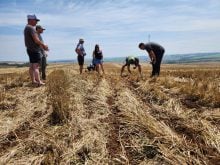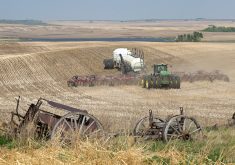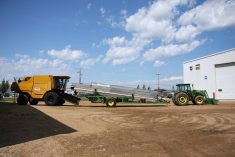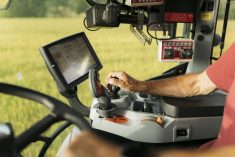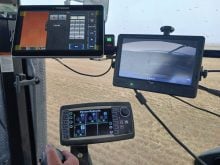DE WINTON, Alta. – One of Canada’s top Thoroughbred training and breeding centres is keeping a nose ahead of the struggling horse racing industry by offering one-of-a-kind rehabilitation services.
Bar None Ranches Ltd. recently bought a hyperbaric oxygen chamber, believed to be the only one used for horses in Canada.
By infusing pure oxygen into the machine – up to 16 times that of the regular atmosphere – it creates a pressurized environment and boosts oxygen in the bloodstream.
It is thought that new blood cells are created, promoting healing of infected wounds, injured muscles, ligaments and tendons. Bought six weeks ago, it is already in high demand.
Read Also

Quebec pork company calls for transparency around gene-edited pigs
Quebec-based pork company duBreton is calling for transparency around meats from gene-edited pigs on concerns that a lack of mandatory labelling will confuse consumers, and dilute certification claims. The organic sector is also calling for labelling rules.
“We’re almost running it 24 hours a day. It puts us on the cutting edge of technology,” said barn manager Mike Vanin.
“It can be used for anything that needs healing. There may not be a specific injury but just general wear and tear.”
Competitors such as rodeo contestants also may be looking for an advantage before an event, he added.
“We’ve got some horses that may be coming in just before the Calgary Stampede.”
Horses are locked in the two-horse chamber for two hours.
“They don’t mind it because it’s not all that different from standing in a horse trailer,” Vanin said.
The number of sessions required varies, depending on the ailment.
Thermography cameras are used as a diagnostic tool to detect areas of heat in a horse before and after hyperbaric treatment. Heat indicates inflammation.
Vanin said the treatment’s long-run success remains to be seen.
“That’s why we involve vets on a regular basis.”
Bar None is best known as a Thoroughbred facility, but it accepts all breeds for training and rehabilitation. Vanin said it receives referrals from vets, and specific treatments are done in consultation with a vet.
“It’s all part of our diversification,” he said.
The ranch, located near De Winton south of Calgary, handles running Quarter horses, as well as polo, barrel racing, steer wrestling, chuck wagon and reining horses.
Rehabilitation equipment allows Bar None to diversify at a time when Alberta’s horse racing industry is hobbled by lack of a major track in Calgary, Vanin said. Construction of a new track just north of the city, has been delayed because of a funding shortfall.
“That’s why we’re diversifying. We want to make the equipment available to all Alberta horses.”
However, there’s no mistaking that Bar None was built for Thoroughbreds. Surrounded by a white plank perimeter fence with a five-furlong track at the entrance, it is a unique facility, especially in a province better known for ranch Quarter horses than fleet-footed hot-bloods.
Established in the early 1980s, it now boasts three 100-stall barns, staff farriers and a vet on site every day of the week. Nine staff live on site.
“So many people drive by here and wonder what it is,” Vanin said.
“We train Thoroughbreds for the track, but this place was built for Alberta horsemen, all Alberta horsemen.”
Eighty horses train at Bar None at any given time. Track workouts are done in the morning and the remainder of the day is devoted to injury prevention.
Horses may be worked on an Equi-Ciser, a technologically advanced hot walker that allows eight horses to be exercised at one time.
The speed can be adjusted, and there is an auto-reverse direction so horses are worked equally on both sides of their bodies.
“Because there are no riders on their back, there is no concussion,” Vanin said.
The footing is sand and crushed rubber.
Walking on water
Injuries also can be treated in the AquaPacer, a narrow tank that fills with water once a horse enters. The animal then walks on a treadmill, against water resistance.
“The more water that is in it, the less weight is on the horse’s legs,” Vanin said.
This exercise helps to reduce inflammation and recovery time, while building strength.
Because of the value of race horses, they are not allowed to frolic in a pasture. The stalled horses are fed quality hay, oats and supplements and are routinely tested to ensure they are receiving proper nutrition.
Bar None grows its own hay and grain, with about one-third of the feed kept for its own horses and the rest sold to the public.
Indoor stabling is pristine, with high ceilings and ventilation to keep dust levels low.
“It’s about air quality,” Vanin said. “We have to keep the air clean.”
The sluggish economy has resulted in fewer mares brought in for breeding, but Bar None’s stallions are leaving their mark on the race track.
In 2007, it bought Gilded Time, an 18-year-old champion race horse and proven sire that demands a $7,500 stud fee, the highest in Alberta.
His successful son Gayego is a strong contender in the upcoming Breeders’ Cup Sprint, to be held Nov. 7 in Santa Anita, California.
“That’s the World Series of Thoroughbred racing,” Vanin said.
“If he were to win, that would make Gilded Time the leading sire in Canada. That would be a first for a Western Canada-based stallion.”




